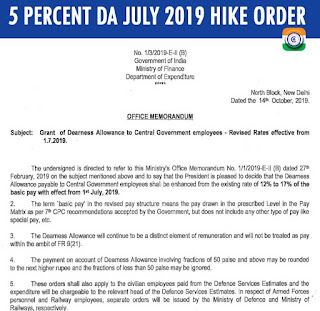National Holiday Allowance – Upward revision of rates: NFIR
Railway Board.
NewDelhi
Dear Sir.
Sub: National Holiday Allowance – Upward revision of rates -reg.
Ref: (i) NFlR‘s PNM item No. 5/2013.
(ii) Railway Board’s letter No. E(P&A)1-2013/FE-4/3 dated 02/05/2014.
(iii) NFlR’s Letter No.1/5(g)/Part.V dated 12/12/2014.
While discussing NFlR’s PNM item No. 5/2013 in the PNM meeting, the Official Side stated that the Federation’s reply dated 12/12/2014 has been examined by the Board, but however, it has been found that the demand of the Federation to compute NHA by taking into account DA in addition to Basic Pay and Grade Pay and at one and halftime the normal rate prevalent till 1968 is not feasible of acceptance.
In this connection. Federation desires to state that the view taken by the Railway Board is not acceptable to NHR as it does not contain justified and valid reasons. The Federation places below following facts which are required to be taken into consideration for giving justified decision.
(a) The decision of the Railway Board is a clear departure from its original decision which was based on the concept that the Railway employees who are not permitted to avail National Holiday in the exigencies of services have to be compensated by payment of additional amount equal 11/2 times of pay (pay in pay band + grade pay) and dearness allowance thereon. The quantum of compensation was clearly laid down which cannot be changed unilaterally by the Railway Board.
(b) The Vth Central Pay Commission though did not favour the continued payment of National Holiday Allowance. had recommended that the staff who are required to be booked on holidays to perform duties. may be paid Over Time Allowance at the prescribed rates.
NFIR therefore requests the Railway Board to review and accept one of the two options mentioned at (a) or (b) above and grant revision of rates. In case there is still reservation on the part of Railway Board. a meeting may be converted for separate discussion.
[https://drive.google.com/file/d/0B40Q65NF2_7UN3lrWGR5bnBWaUk/view]
NFIR
National Federation of Indian Railwaymen
3, CHELMSFORD ROAD, NEW DELHI – 110 055
Affiliated to:
Indian National Trade Union Congress (INTUC)
International Transport Workers Federation (ITF)
No. 1/5(g)/Part.VNational Federation of Indian Railwaymen
3, CHELMSFORD ROAD, NEW DELHI – 110 055
Affiliated to:
Indian National Trade Union Congress (INTUC)
International Transport Workers Federation (ITF)
Dated: 03/07/2015
The Secretary (E),Railway Board.
NewDelhi
Dear Sir.
Sub: National Holiday Allowance – Upward revision of rates -reg.
Ref: (i) NFlR‘s PNM item No. 5/2013.
(ii) Railway Board’s letter No. E(P&A)1-2013/FE-4/3 dated 02/05/2014.
(iii) NFlR’s Letter No.1/5(g)/Part.V dated 12/12/2014.
****
While discussing NFlR’s PNM item No. 5/2013 in the PNM meeting, the Official Side stated that the Federation’s reply dated 12/12/2014 has been examined by the Board, but however, it has been found that the demand of the Federation to compute NHA by taking into account DA in addition to Basic Pay and Grade Pay and at one and halftime the normal rate prevalent till 1968 is not feasible of acceptance.
In this connection. Federation desires to state that the view taken by the Railway Board is not acceptable to NHR as it does not contain justified and valid reasons. The Federation places below following facts which are required to be taken into consideration for giving justified decision.
(a) The decision of the Railway Board is a clear departure from its original decision which was based on the concept that the Railway employees who are not permitted to avail National Holiday in the exigencies of services have to be compensated by payment of additional amount equal 11/2 times of pay (pay in pay band + grade pay) and dearness allowance thereon. The quantum of compensation was clearly laid down which cannot be changed unilaterally by the Railway Board.
(b) The Vth Central Pay Commission though did not favour the continued payment of National Holiday Allowance. had recommended that the staff who are required to be booked on holidays to perform duties. may be paid Over Time Allowance at the prescribed rates.
NFIR therefore requests the Railway Board to review and accept one of the two options mentioned at (a) or (b) above and grant revision of rates. In case there is still reservation on the part of Railway Board. a meeting may be converted for separate discussion.
Yours faithfully
(Dr. M. Raghavai)
General Secretary
Source: NFIRGeneral Secretary
[https://drive.google.com/file/d/0B40Q65NF2_7UN3lrWGR5bnBWaUk/view]










